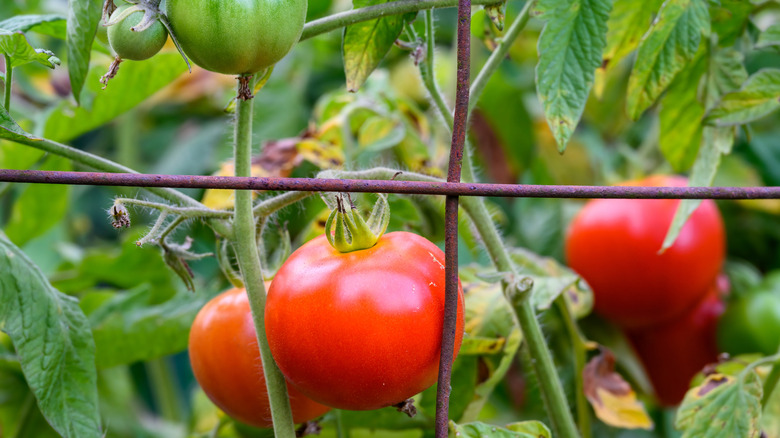DIY A Tomato Cage With The Help Of Old Wire Fencing
While there are many ways to support your tomato plants as they grow, tomato cages have some particularly great benefits for the plants. When growing tomatoes in a cage, you do not have to prune or train the plant. Plus, a tomato cage forces your tomato plant to grow densely, helping to prevent sunscald. A tomato cage can be as inexpensive as about $5, but some options are a lot pricier. Despite their affordable nature, there are some valid reasons to create your own DIY tomato cage. First, a DIY version gives you the opportunity to fully customize the size and shape of the cage to best accommodate your individual plant. Plus, you can help the environment by reusing materials instead of buying new ones. For example, you can repurpose old wire fencing that you have on your property or that you acquire from someone else to keep it out of the landfill.
If you want to create your own DIY tomato cage using old wire fencing, the process is fairly simple. You will need to take some proper safety precautions, especially if the old wire has any rust or sharp edges on it. Find yourself some old wire fencing, which should be easy, considering it is one the common affordable fencing ideas to enclose a yard. If you don't have any, ask friends and neighbors or check on local Facebook groups. Next, gather some supplies like gloves, bolt or wire cutters, pliers, and measuring tools. Because wire fencing is strong, you will not need wooden stakes or additional support options like you do when using more flexible materials like chicken wire.
How to safely create a tomato cage using old wire
To create a tomato cage using old wire fencing, first make sure you take some safety precautions. Wear gloves, long sleeves, and long pants to protect yourself from rust and sharp edges. When cutting wire, make sure you wear eye protection as well. Once you are prepared, you can start cutting the wire to create the cages. Each cage should be about 24 to 30 inches in diameter, which can be achieved using a panel of at least 6 feet. The cage should also be about 5 feet tall. However, you should tailor the cage to suit your particular plant's needs since different varieties of tomatoes grow to various sizes.
When cutting the wire fence, leave an extra length of wire at what will be the bottom of the cage. This will make it easy to stand the cage upright by pushing these lengths into the ground, similar to the metal stakes on the bottom of a commercial tomato cage. On one side of your cage panel, cut near the intersections of the wires. On the other side, leave some length. Then, use pliers to bend the wire and hook the pieces on the other side to create the circle and secure the panel into the cage shape. You can also use additional wire to secure the shape if necessary.
When the cage is finished, place it over your growing tomato plant, ideally in the spring before the plant gets too large. You can also use the DIY cage if you grow tomatoes in containers. Just make sure the wire fence cage fits within the container.
